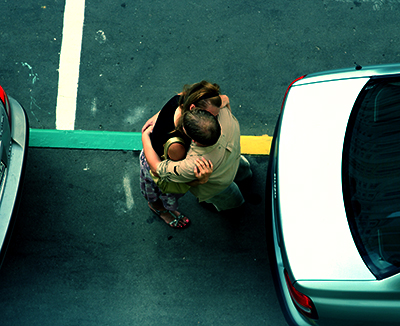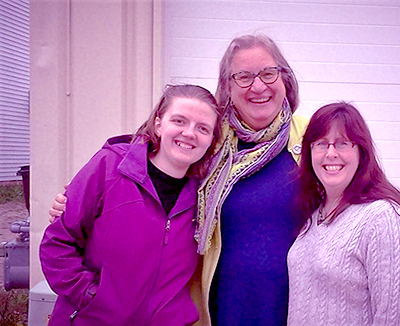by Anne Edison-Albright
They started to notice a pattern. About a week or two before Bob had to leave for his next military deployment, Bob and Barb would start fighting. Usually it was about something little, but the arguments didn’t feel little at the time. When they realized the pattern and the timing of the pattern, they realized they were subconsciously creating a family goodbye ritual. As the deployment date neared, one or both would anticipate the grief of parting and pick a fight to make saying goodbye feel a little easier.
Once they realized it, Barb and Bob did their best not to engage in that goodbye ritual anymore. But they also knew . . . when the kids started to pick fights before leaving for college, when tensions rose around transitions inside and outside the family . . . . “Aha!” they’d think. “It’s that goodbye thing again.” And they’d move to address what they were feeling in more intentional ways.
An end, a beginning of something else
 Saying goodbye is part of life, and some goodbyes are more challenging than others. Just as we are culturally uncomfortable with the idea of death, we are uneasy with goodbyes and try to ignore them or look for easy ways out of them. But the intentional marking of the end of something—and the beginning of another thing—can be a real source of healing and hope for everyone involved. Facing and naming the emotions and tasks of leave-taking directly and asking for God’s help with this can be work that congregations can help families and individuals address.
Saying goodbye is part of life, and some goodbyes are more challenging than others. Just as we are culturally uncomfortable with the idea of death, we are uneasy with goodbyes and try to ignore them or look for easy ways out of them. But the intentional marking of the end of something—and the beginning of another thing—can be a real source of healing and hope for everyone involved. Facing and naming the emotions and tasks of leave-taking directly and asking for God’s help with this can be work that congregations can help families and individuals address.
There are many liturgical resources to draw from and many ways to craft a meaningful goodbye.
Intentional or not, you will probably end up with some kind of goodbye ritual. With an intentional goodbye, you engage in the counter-cultural work of approaching the end of something with courage and hope.
Meaning goodbye
My first encounter with goodbye rituals came when I was in high school and having a hard time accepting a breakup with a first love. My mom said, “You need to say goodbye and actually mean it. You need to write a ritual, a Ritual of Meaning Goodbye.” We brainstormed some ideas for an outline and I filled in the details: quotes from favorite poems and songs, a part where a friend asked, “Are you ready to be done with this relationship?” and I answered that I was, and other parts that mirrored liturgical elements, but through a very personal lens. My parents and my two best friends and I went through the ritual on my back porch, and I remember feeling empowered and renewed. My desire to say goodbye and mean it wasn’t just internal anymore; it was something I’d shared and made real with the help of people who loved me.
Fast-forward many years to seminary, where the Rev. Dr. Pamela Cooper-White taught our pastoral-care class about ways that churches can be a supportive partner in healthy leave-taking for couples who are breaking up or divorcing. There are rites in use for couples to officially end their marriage within a church setting. These rites include promises to treat one another with respect, to maintain healthy communication (particularly when there are children) and to acknowledge that the marriage is ending. Prayers are raised asking for God’s guidance and love, and continued presence with all members of the family.
In my experience as a pastor, I’ve offered this rite to a few couples, but haven’t yet encountered a situation where both parties want this kind of intentional, formal goodbye. I will keep offering it, though, because while the formal steps of the legal process of divorce create their own rituals and meaning, the liturgical rite creates a connection between the way the marriage began—with a wedding that invited God to bless and be present in the relationship—and the way it is ending—with a rite that invites God to be present for the end of the relationship, and to continue to love and guide both individuals and their larger network of family and friends.
While we work in the church to support marriages, we also provide support when marriages end. The unconditional love of God as expressed by a caring faith community can be an incredible resource for people going through divorce and other significant breakups.
A new name
 I was getting to know Lindy, a woman who was going through a divorce. The decision had been many years in the making. We talked about goodbye rites and rituals, and about how she was marking the end of that time in her life and the new beginnings ahead. After a few weeks, she told me she’d decided to change her first and last name and asked if we could mark the change in some way during worship at church.
I was getting to know Lindy, a woman who was going through a divorce. The decision had been many years in the making. We talked about goodbye rites and rituals, and about how she was marking the end of that time in her life and the new beginnings ahead. After a few weeks, she told me she’d decided to change her first and last name and asked if we could mark the change in some way during worship at church.
In the Bible, God gives people new names when they are taking on a new mission or a new aspect of their identity. Like Abraham, Sarah, Peter and Paul, Lindy was taking on more than a name—she was developing, with God’s help, a new sense of identity and way of relating to the world.
We adapted a liturgical naming rite for transgender church members from the House for All Sinners and Saints. The rite, which honors the old name while clearly and fully taking on the new name, was a gift to Lindy, her family, and the whole congregation. It was especially meaningful for other abuse survivors in the congregation, who experienced the rite as healing and empowering not only for Lindy, but for themselves, too.
Farewell and godspeed
In Occasional Services for the Assembly (Evangelical Lutheran Worship, 2009) there are several rites for saying goodbye, with prayers and Scripture passages that can be used in many different situations, including families leaving a congregation or to mark the end of a job or a call to ministry.
The service of “Farewell and Godspeed” recommends verses on angels sent ahead to guard and guide your way (Exodus 23:20,) promises to walk with you through fire and water (Isaiah 43: 1-3) and Jesus’ promise to be your light in all times and places (John 8:12.) The order for “Thanksgiving at the Conclusion of a Call” includes a crucial exchange where the congregation is asked, “Do you release this leader from service?” and they respond, “I do, and I give thanks to God for our ministry together.” Then the leader is asked, “Do you recognize and accept the completion of your ministry?” This sort of direct question and answer is central to all rites and rituals of goodbye. It helps to make sometimes surreal situations of transition and doubt seem more real and meaningful.
Death and resurrection
When Bob was diagnosed with terminal cancer, he and Barb started picking fights again. It was the old goodbye ritual, though of course, after many years of married life, they realized pretty quickly what they were doing. When I got to know them, they were deeply engaged in more intentional goodbye rituals: sharing memories and stories, giving each other gifts of time and once-in-a-lifetime experiences, fully and truly enjoying time with family, friends and congregation. During his last week of life, the family and I gathered around Bob’s bed to share Holy Communion. We knew that it was a goodbye meal, but also a meal that embodied the hope of the resurrection, the promise of a new beginning.
Death and resurrection, endings and beginnings, goodbyes and hellos . . . these are not unfamiliar to us as Christians. We have resources for navigating these often difficult transitions together, whether it be a breakup, the end of employment, moving away, divorce or dying. When we mark leave-taking with rituals, we provide space for healing, hope and community support.
Discussion questions:
1. How have you experienced God in times of transition and saying goodbye?
2. What unintentional and intentional goodbye rituals have you taken part in? What did you learn from them?
3. What can your congregation do to support people during different “meaning goodbye” times?
Closing prayer:
God, you know my going out and my coming in, my endings and my beginnings. Be with me when I’m afraid to say goodbye. Be with me when the door behind me closes and the path ahead of me is unclear. In the daily deaths and resurrections of my life, give me hope in the death and resurrection of Jesus. Amen.
The Rev. Anne Edison-Albright is in the midst of a time of goodbyes, as she leaves her work with the people of Redeemer Lutheran Church in Stevens Point, Wisconsin. She has been called to serve as co-pastor at Luther College in Decorah, Iowa.
Photos of the mug and book and couple embracing by Morguefile.com. Photo of Lindy and her family, courtesy of Lindy. Used with permission.


*Love*